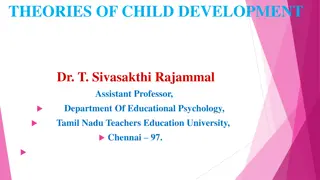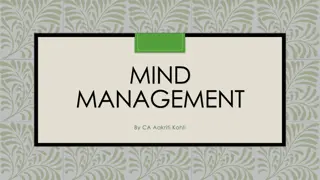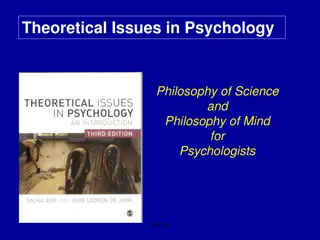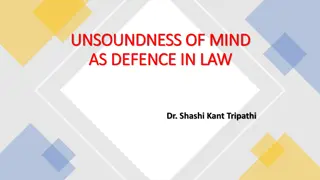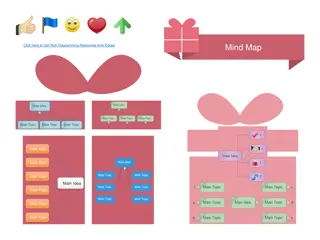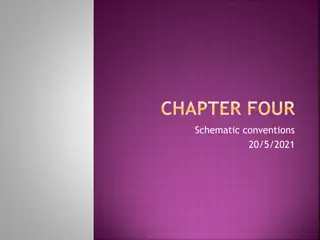Understanding Theory of Mind Development in Children
Explore the role of Perceptual Access Reasoning (PAR) in theory of mind development through topics like false-belief tasks, reasoning about desires and beliefs, and understanding false beliefs in young children. Learn how children perceive unseen mental states and predict behaviors based on beliefs and desires. Discover the cognitive milestones in theory of mind development and the implications for research methodologies and theoretical frameworks.
Download Presentation

Please find below an Image/Link to download the presentation.
The content on the website is provided AS IS for your information and personal use only. It may not be sold, licensed, or shared on other websites without obtaining consent from the author. Download presentation by click this link. If you encounter any issues during the download, it is possible that the publisher has removed the file from their server.
E N D
Presentation Transcript
For this issue, visit doi.org/10.1111/mono.12432 For videos, commentaries, and teaching materials, visit monographmatters.srcd.org Monograph Matters is the companion website for Monographs of the Society for Research in Child Development
The Role of Perceptual Access Reasoning (PAR) in the Development of Theory of Mind Monograph Matters is a companion website for Monographs of the Society for Research in Child Development Lynn S. Liben, Editor
Topics I. II. Classic False-Belief Tasks III. Perceptual Access Reasoning IV. Methodological Implications V. Theoretical Implications Theory of Mind Monograph Matters is the companion website for Monographs of the Society for Research in Child Development
I. What is Theory of Mind (ToM)? Understanding that behavior is caused by unseen mental states (e.g., beliefs, desires, intentions). Allows us to predict and explain other people s behaviors. Example: How would a young child explain why someone left the house with an umbrella? Monograph Matters is the companion website for Monographs of the Society for Research in Child Development
Reasoning About Desires 3-year-olds can reason about people s desires. A 3-year-old might say, Because she likes her umbrella. 3-year-olds typically cannot also reason about people s beliefs. A 3-year-old would not likely say, Because she thinks it will rain. Monograph Matters is the companion website for Monographs of the Society for Research in Child Development
Reasoning About Desires and Beliefs How would an older child, Bobby, reason about Kayla s desire and belief, in order to predict where Kayla will go? I know that Kayla wants a cookie. I can predict that Kayla will go to the cookie jar. I know that Kayla thinks there are cookies in the jar. Monograph Matters is the companion website for Monographs of the Society for Research in Child Development
Reasoning About False Beliefs Young children have difficulty understanding that people can believe something that is not true; i.e., that people can have false beliefs. Understanding false belief is a big step toward understanding that minds represent the world, sometimes in profoundly different ways. Monograph Matters is the companion website for Monographs of the Society for Research in Child Development
How would Bobby reason about Kaylas false belief? I know the cookies have been placed out for Kayla, I know Kayla falsely believes the cookies are in the jar. and I know Kayla doesn t see them. Monograph Matters is the companion website for Monographs of the Society for Research in Child Development
II. The Classic False-Belief Tasks In the 1980s, researchers devised False-Belief tasks to investigate when and how children come to understand that a person can hold a false belief. Monograph Matters is the companion website for Monographs of the Society for Research in Child Development
The Maxi False-Belief task (Location task) The Smarties False-Belief task (Contents task) The Classic False-Belief Tasks are 2-Option Tasks, meaning that the test question presents the child with a forced-choice between two possible answers. Monograph Matters is the companion website for Monographs of the Society for Research in Child Development
The Classic Maxi Task Monograph Matters is the companion website for Monographs of the Society for Research in Child Development
The Classic Maxi Task Monograph Matters is the companion website for Monographs of the Society for Research in Child Development
The Classic Maxi Task 3-year-olds typically answer incorrectly, Green. They use Reality Reasoning; i.e., Maxi wants his chocolate, so he will go to where it really is to get it. 5-year-olds typically answer correctly, Blue. However, correct answers do not necessarily mean that children understand that Maxi has a false belief. Monograph Matters is the companion website for Monographs of the Society for Research in Child Development
The Classic Smarties Task Monograph Matters is the companion website for Monographs of the Society for Research in Child Development
The Classic Smarties Task Monograph Matters is the companion website for Monographs of the Society for Research in Child Development
The Classic Smarties Task 3-year-olds typically answer incorrectly, Pencil. They use Reality Reasoning; i.e., the newcomer will say pencil, because that s what is really inside. 5-year-olds typically answer correctly, Smarties. However, correct answers do not necessarily mean that children understand that the newcomer has a false belief. Monograph Matters is the companion website for Monographs of the Society for Research in Child Development
III. Perceptual Access Reasoning (PAR) Children can pass the Classic, 2-Option False-Belief Tasks without understanding false belief, by using Perceptual Access Reasoning (PAR). Monograph Matters is the companion website for Monographs of the Society for Research in Child Development
PAR is Composed of Two Rules: Rule 1: Seeing, or other forms of perceptual access, leads to knowing, and not seeing leads to not knowing. Rule 2: Knowing leads to getting it right, and not knowing leads to getting it wrong. Monograph Matters is the companion website for Monographs of the Society for Research in Child Development
How PAR Applies to the Classic, 2-Option Smarties False-Belief Task Rule 1: Bunny can t see the pencil, so she doesn t know there s a pencil inside. Rule 2: Bunny doesn t know there s a pencil inside, so she ll get it wrong and she ll say, Smarties. With 2 options, there is only 1 way to get it wrong (Smarties), so PAR gives the false-belief answer by default. Monograph Matters is the companion website for Monographs of the Society for Research in Child Development
How PAR Applies to the Classic, 2-Option Smarties False-Belief Task Rule 1: When Maxi comes back, he can t see the chocolate in the green cupboard, so he doesn t know it s in the green cupboard. Rule 2: He doesn t know it s in the green cupboard, so he ll get it wrong, and look in the blue cupboard. With 2 options, there is only 1 way to get it wrong, (blue), so PAR gives the false-belief answer by default. Monograph Matters is the companion website for Monographs of the Society for Research in Child Development
IV. Methodological Implications In all of the 2-Option False-Belief Tasks, reasoning about false beliefs is confounded with PAR. New methods exist to remove the confound between belief reasoning and PAR. Monograph Matters is the companion website for Monographs of the Society for Research in Child Development
Ways to remove the confound in Maxi tasks 3-Option False-Belief tasks No-Belief tasks True-Belief tasks Maxi puts it in red and leaves Mom puts it in yellow Changes her mind moves it to blue Maxi returns Maxi puts it in red Maxi watches Mom put it in blue Maxi leaves Maxi returns Mom puts it in red Changes her mind moves it to blue Maxi enters for the first time Responses generated by each reasoning strategy Reality Reasoning = blue PAR = red Belief Reasoning = blue Reality Reasoning = blue PAR = random (red/yellow) Belief Reasoning = red Reality Reasoning = blue PAR = red Belief Reasoning = random (red/blue) Monograph Matters is the companion website for Monographs of the Society for Research in Child Development
Ways to remove the confound in Maxi tasks 3-Option False-Belief tasks True-Belief tasks No-Belief tasks http://tbn2.google.com/images?q=tbn:pThqWsb7-B7whM:http://bp1.blogger.com/_3F-13pST584/SHNDjjBKcII/AAAAAAAAAgk/rP-bNuGcDYQ/s400/Little%2BWhite%2BBox.jpg Take out pencil; put in key Take out pencil; put in key Take out pencil; put in Smarties Responses generated by each reasoning strategy Reality Reasoning = key PAR = random (Smarties/pencil) Belief Reasoning = Smarties Reality Reasoning = Smarties PAR = pencil Belief Reasoning = Smarties Reality Reasoning = key PAR = pencil Belief Reasoning = random (key/pencil) Monograph Matters is the companion website for Monographs of the Society for Research in Child Development
The Belief Understanding Scale (BUS) has been derived from these new methods to remove the confound. (see related video) Children are given a 2-Option False-Belief Smarties task paired with a 2-Option True-Belief Smarties task, and are asked to justify their answers. False-Belief task True-Belief task The BUS is recommended to be used in research on the development of representational ToM. Monograph Matters is the companion website for Monographs of the Society for Research in Child Development
IV. Theoretical Implications PAR is a non-representational ToM. PAR is the developmental precursor of belief reasoning. Findings challenge the long-standing view that children acquire a representational ToM during the preschool years. Instead, findings indicate that children use PAR during the preschool years, and do not understand true or false beliefs until about age 7. Findings cast doubt on claims that representational ToM is innate. PAR theory poses an exciting new developmental question: How do children construct a new concept of representational mind from PAR? Monograph Matters is the companion website for Monographs of the Society for Research in Child Development
For this issue, visit doi.org/10.1111/mono.12432 For videos, commentaries, and teaching materials, visit monographmatters.srcd.org Monograph Matters is the companion website for Monographs of the Society for Research in Child Development
Editorial inquiries Lynn S. Liben liben@psu.edu Corresponding author William Fabricius, PhD William.Fabricius@asu.edu Citation Fabricius, W. V., Gonzalez, C. R., Pesch, A., Weimer, A. A., Pugliese, J., Carroll, K., Bolnick, R., Kupfer, A. S., Eisenberg, N., & Spinrad, T. (2021). Perceptual access reasoning (PAR) in developing a theory of mind. Monographs of the Society for Research in Child Development, 86(3). https://doi.org/10.1111/mono.12432 Monograph Matters is the companion website for Monographs of the Society for Research in Child Development
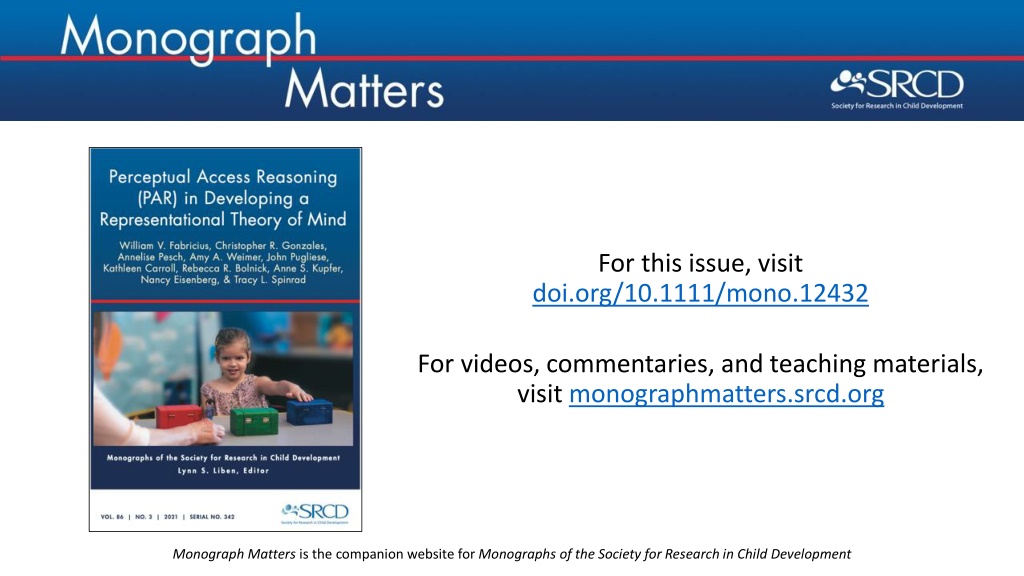

![[PDF⚡READ❤ONLINE] Zen Mind, Beginner's Mind: 50th Anniversary Edition](/thumb/20459/pdf-read-online-zen-mind-beginner-s-mind-50th-anniversary-edition.jpg)

